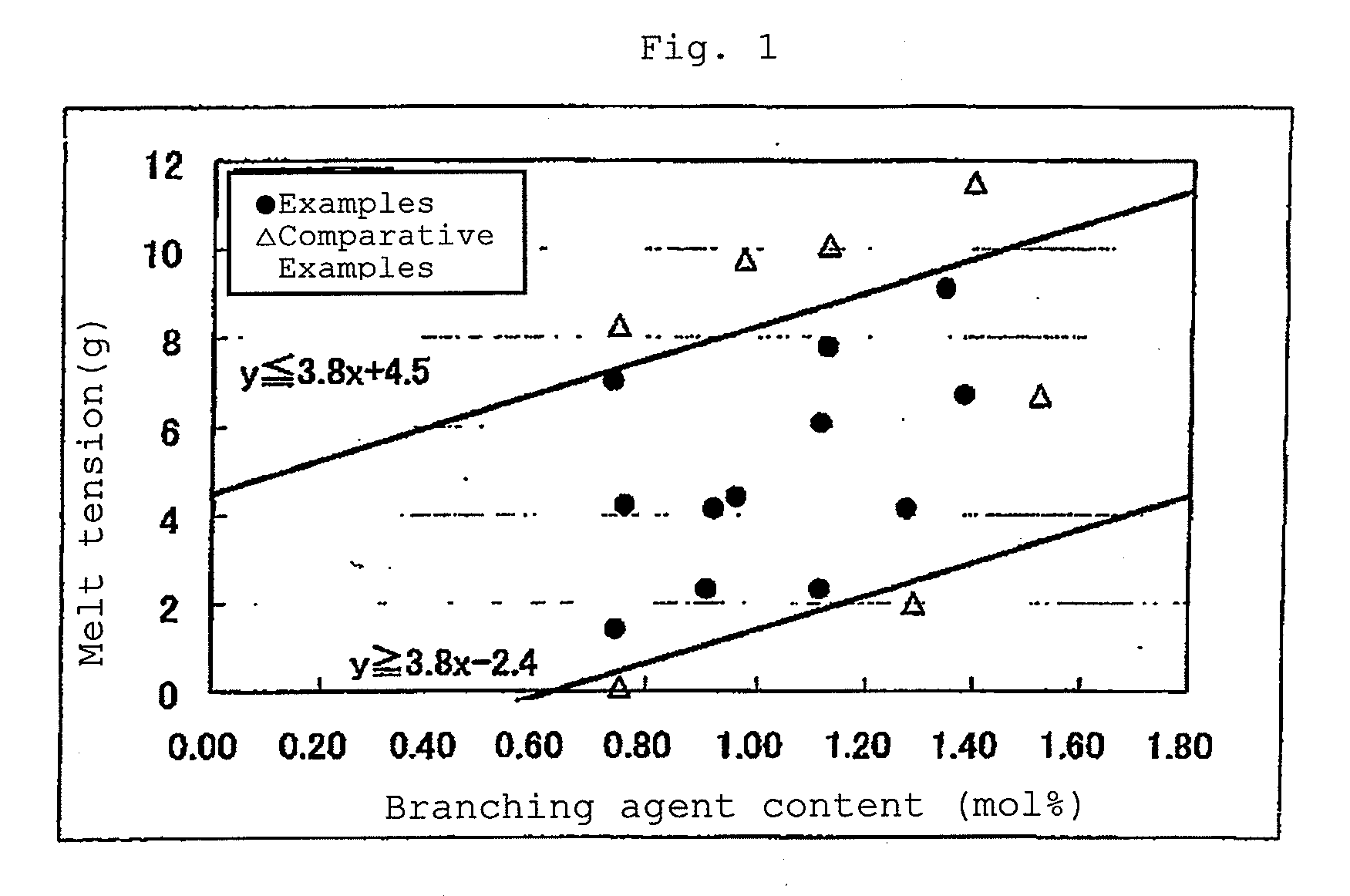Branched polycarbonate resin and process for producing the same
a polycarbonate resin and branched technology, applied in the field ofbranched polycarbonate resin, can solve the problems of insufficient thermal stability of branched polycarbonate resin for extrusion molding, blow molding, vacuum molding, etc., and achieve the effects of stable molding, good melt tension, and stable production
- Summary
- Abstract
- Description
- Claims
- Application Information
AI Technical Summary
Benefits of technology
Problems solved by technology
Method used
Image
Examples
example 1
(Step of Obtaining Polycarbonate Oligomer)
[0058]A reactor with a thermometer, a stirrer and a reflux condenser was charged with 2,340 parts of deionized water, 947 parts of a 25% sodium hydroxide aqueous solution and 0.7 part of hydrosulphite, and 710 parts of bisphenol A was dissolved with stirring (bisphenol A solution). Then, 2,299 parts of methylene chloride, 112 parts of a 48.5% sodium hydroxide aqueous solution and 38.1 parts (1.00 mol %) of a solution of 25% concentration of 1,1,1-tris(4-hydroxyphenyl)ethane in a 14% concentration sodium hydroxide aqueous solution were added, and 354 parts of phosgene was introduced over about 90 minutes by blowing at 15 to 25° C. to carry out a phosgene forming reaction, whereby a polycarbonate oligomer was obtained.
(Emulsification)
[0059]After the phosgene forming was completed, 219 parts of a methylene chloride solution of 11% concentration p-tert-butylphenol and 88 parts of a 48.5% sodium hydroxide aqueous solution were added, and the stir...
example 2
[0065]Example 1 was repeated except that the amount of phosgene was changed to 357 parts, that the amount of the solution of 25% concentration of 1,1,1-tris(4-hydroxyphenyl)ethane in a 14% concentration sodium hydroxide aqueous solution was changed to 57.2 parts (1.50 mol %) and that the amount of the methylene chloride solution of 11% concentration p-tert-butylphenol was changed to 240 parts, and Table 1 shows the evaluation results of the thus-obtained branched polycarbonate resin pellets.
example 3
[0066]Example 1 was repeated except that the amount of phosgene was changed to 352 parts, that the amount of the solution of 25% concentration of 1,1,1-tris(4-hydroxyphenyl)ethane in a 14% concentration sodium hydroxide aqueous solution was changed to 30.5 parts (0.80 mol %) and that the amount of the methylene chloride solution of 11% concentration p-tert-butylphenol was changed to 209 parts, and Table 1 shows the evaluation results of the thus-obtained branched polycarbonate resin pellets.
PUM
| Property | Measurement | Unit |
|---|---|---|
| viscosity average molecular weight | aaaaa | aaaaa |
| thermal stability | aaaaa | aaaaa |
| moldability | aaaaa | aaaaa |
Abstract
Description
Claims
Application Information
 Login to View More
Login to View More - R&D
- Intellectual Property
- Life Sciences
- Materials
- Tech Scout
- Unparalleled Data Quality
- Higher Quality Content
- 60% Fewer Hallucinations
Browse by: Latest US Patents, China's latest patents, Technical Efficacy Thesaurus, Application Domain, Technology Topic, Popular Technical Reports.
© 2025 PatSnap. All rights reserved.Legal|Privacy policy|Modern Slavery Act Transparency Statement|Sitemap|About US| Contact US: help@patsnap.com

